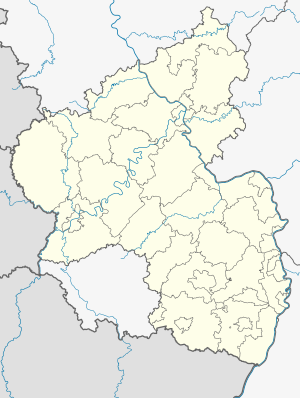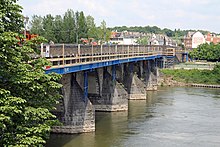Balduin Bridge
Coordinates: 50 ° 21 ′ 50 ″ N , 7 ° 35 ′ 35 ″ E
| Balduin Bridge | ||
|---|---|---|
| View of the Baldwin Bridge from the west | ||
| use | Street, footpath and bike path | |
| Crossing of | Moselle | |
| place | Koblenz | |
| Entertained by | City of Koblenz | |
| construction | stone arch bridge / prestressed concrete bridge | |
| overall length | 475 m | |
| width | 12 m | |
| vehicles per day | 19,000 | |
| start of building | around 1342/1343 | |
| completion | 1429 | |
| construction time | about 85 years | |
| planner | Baldwin of Luxembourg | |
| location | ||
|
|
||
| Road map of Koblenz | ||
| 3 = Balduin Bridge | ||
The Balduin Bridge is a stone arch bridge over the Moselle in Koblenz . The city's oldest surviving bridge was built in the 14th century. At km 1.04 it is the last bridge over the Moselle before it flows into the Rhine at the Deutsches Eck and connects the old town of Koblenz with the Lützel district to the north . It takes its name from the Trier Elector Baldwin of Luxembourg , under whom the construction of the bridge began. In the course of time the Balduin Bridge underwent some, sometimes considerable, modifications.
history
Roman predecessor bridge
There was already a Moselle crossing at this point before the Balduin Bridge. In the years between 1860 and 1867, 50 meters downstream next to the Balduin Bridge, the remains of a Pfahljoch bridge from Roman times were discovered, which was part of the Roman Rhine Valley Road . Dredgers that were used to expand the shipping channel (1944) and to build the Koblenz barrage (1940–1951) removed numerous remains of this wooden bridge from the river bed.
Bridge building in the Middle Ages
The first construction of the Balduin Bridge began under Elector Balduin of Luxembourg around 1342/1343. A certificate issued by him about the beginning of the bridge construction dates from May 1, 1343. On June 28, 1359 Archbishop Boemund II of Saarbrücken granted the right to collect bridge fees. Construction work on the bridge took about 85 years. With the construction of the gate tower in 1429, the bridge was finally completed. The Pope in Rome repeatedly granted indulgences to finance the construction of the bridge, which represented a great technical and financial challenge , the reason being the facilitation of pilgrimage. The foundations for the bridge formed their own assets, which were managed by their own bridge master until the end of the Trier electorate and ensured the necessary funds for the maintenance of the bridge. The stone parapet wall carried a statue of Saint Nepomuk , the patron saint of the bridges. At least for a time, there were also small houses on the bridge or its pillars, which the Jewish population lived in.
Modifications in the 17th to 19th centuries
The bridge was repeatedly damaged by floods and ice. In the 17th century the first change took place in the course of the baroque fortification of the city of Koblenz. On the Lützel side, the gate system on the abutment was removed in the 18th century, and the gate tower on the Koblenz side was removed in 1775. In 1794, during the march of French revolutionary troops, the statue fell into the Moselle.
In the course of the expansion of the Prussian fortress in Koblenz , the Balduin Bridge was also secured. According to the plans of the engineer officer Heinrich Adolph Buschbeck , the Moselle gate (also known as the Moselle gate battery) was built between 1821 and 1824 on the city side, which was finally plastered in 1834 and demolished in 1897 after the city fortifications were abandoned, as well as a truss tower on the Lützel side between 1831 and 1832 which was removed in 1883 when the bridge was widened.
War destruction and reconstruction
At the end of the Second World War, the Balduin Bridge, like all Koblenz bridges, was blown up on March 7, 1945 by the retreating units of the Wehrmacht . In the process, three arches on the Koblenz side fell into the Moselle, which were then temporarily repaired. The completion of the reconstruction (1946-1949) was celebrated on August 23, 1949 in the presence of the Rhineland-Palatinate Prime Minister Peter Altmeier .
Modifications since 1949
The Moselle canalization in the 1960s also had consequences for the Balduin Bridge. Parts were broken off to make way for shipping. Since then, a modern prestressed concrete bridge has spanned the shipping canal on the northern half . For this purpose, six arches had to be broken off on the Lützel side. The arches that have been preserved were widened by around five meters on the upstream side, so that the bridge is around twice as wide today as it was in the Middle Ages. On this occasion, the iron pedestrian walkways from the 19th century were removed and the parapet walls were reconstructed in their old form. In 1975 the rebuilt and restored bridge was completed after a long construction period. On the bridge, a stone figure, created by the Koblenz sculptor Rudi Scheuermann , commemorates the eponymous Elector Baldwin of Luxembourg. In the archway on the Koblenz side hangs an expressive Christ the King's cross (relief), which was created in the 1970s by the East Prussian sculptor Siegfried Erdmann (today Dortmund), next to it there is an inscription plaque from the 18th century, which is widened The bridge was attached to one of the pillars, it is reminiscent of a repair and bears the name of a former bridge master.
In February 2013, extensive renovation measures began on the Balduin Bridge, which lasted until October 2014 and were carried out by Faber Bau GmbH . Due to environmental influences and the high traffic load - 19,000 vehicles and 800 regular buses use the bridge every day - the prestressed concrete structures, the pedestrian underpass and the spiral pedestrian ramp on the Lützel side from the 1970s were particularly badly damaged. But the historic stone arches on the inner city side were also included in the renovation. The entire roadway of the bridge was renewed and the railings were raised to the level required today. The pedestrians and cyclists had to use a temporary bridge on the east side.
construction
The Balduin Bridge was built from Devonian greywacke and volcanic rock ( basalt lava ). Originally the bridge consisted of fourteen arches with thirteen pillars and spanned the Moselle over a length of 325 m between the abutments. All pillars stand on post gratings .
Today it spans the Moselle next to the Old Castle for a length of 246 m between the abutments . The total length of the bridge structure including the approach bridges on both sides is 475 m. Three arches have been preserved on the Lützel side, then a modern prestressed concrete bridge spans the shipping canal, and finally seven historical arches follow on the Koblenz side. The bridge ramp on the Koblenz side is supported by three more powerful arches.
Entry of Kaiser Wilhelm II over the Balduin Bridge, one day before the inauguration of the Kaiser Wilhelm I monument at the Deutsches Eck in 1897
Monument protection
The Balduin Bridge is a protected cultural monument under the Monument Protection Act (DSchG) and entered in the list of monuments of the state of Rhineland-Palatinate . It belongs to the old town monument zone .
The Balduin Bridge has been part of the Upper Middle Rhine Valley UNESCO World Heritage Site since 2002 , and is also a protected cultural asset under the Hague Convention . Therefore it is marked with the blue and white protection symbol.
See also
- List of crossings over the Rhine and Moselle in Koblenz
- List of Moselle bridges
- List of medieval stone bridges in Germany
literature
- Energieversorgung Mittelrhein GmbH (ed.): History of the city of Koblenz . Overall editing: Ingrid Bátori in conjunction with Dieter Kerber and Hans Josef Schmidt
- Volume 1: From the beginning to the end of the electoral era . Theiss, Stuttgart 1992, ISBN 3-8062-0876-X .
- Volume 2: From the French city to the present . Theiss, Stuttgart 1993, ISBN 3-8062-1036-5 .
- Fritz Michel : The art monuments of the city of Koblenz. The mundane monuments and the suburbs. Munich Berlin 1954, pp. 176–180 (Die Kunstdenkmäler von Rheinland-Pfalz, first volume).
- Cultural monuments in Rhineland-Palatinate Volume 3.2. City of Koblenz. City center , edited by Herbert Dellwing and Reinhard Kallenbach , Speyer 2004, ISBN 3-88462-198-X , p. 104.
- State Office for Monument Preservation Rhineland-Palatinate (ed.): The art monuments of the city of Koblenz. The profane monuments and the suburbs (series: Die Kunstdenkmäler von Rheinland-Pfalz), Unchanged reprint from 1954, on behalf of the Ministry of Culture of Rhineland-Palatinate, Deutscher Kunstverlag Munich-Berlin, 1986, ISBN 3-422-00563-3 .
- Hans Bellinghausen , Ernst Bitzegeio, Ulrich Finsterwalder : New Moselle Bridge Koblenz. Festschrift for the inauguration and handover of the New Moselle Bridge Koblenz on July 24, 1954 (extended special print from Der Bauingenieur , year 29, 1954, issue 8), Springer-Verlag Berlin / Heidelberg 1954, ISBN 3-540-01833-6 (online)
- City of Koblenz (ed.): Koblenz city of bridges. Documentation for the inauguration of the Balduin Bridge in Koblenz, Koblenz, August 1975.
Web links
- Balduin Bridge. In: Structurae
- The Balduin Bridge at brueckenweb.de
- Renovation of the Balduin Bridge in: koblenz-baut.de
- The Balduin Bridge in the Art & Architecture picture index
Individual evidence
- ↑ Klaus Weber: The Prussian fortifications of Koblenz (1815-1834) (= art and cultural research . Volume 1 ). 2003, ISBN 3-89739-340-9 , pp. 211-212, 221-223 . Fritz Michel: The art monuments of the city of Koblenz. The profane monuments and their suburbs (= The art monuments of Rhineland-Palatinate . Volume 1 ). Munich 1954, p. 144 .
- ^ Renovation of the Balduin Bridge Koblenz in: structurae.de
- ↑ General Directorate for Cultural Heritage Rhineland-Palatinate (ed.): Informational directory of cultural monuments - district-free city of Koblenz (PDF; 1.5 MB), Koblenz 2013.












